Detecting counterfeit currency, Australian dollars
by tonytran2015 (Melbourne, Australia).
Click here for a full, up to date ORIGINAL ARTICLE and to help fighting the stealing of readers’ traffic.
(blog No. 29)
#Australian, #counterfeit, #currency, #detect, #dollar, #fake, #feature, #money, #polymer
There are many countries in the world using polymer currency notes. Australia, Canada, the EU, UK are among them. Being unfamiliar with the characteristics of polymer notes may expose you to significant real risk of loss by receiving counterfeit changes.
This posting shows the most effective ways to distinguish between real and counterfeit Australian polymer notes. Vietnamese polymer currency notes [3,4] (printed under technology licensed by Note Printing Australia, a wholly owned subsidiary of the Reserve Bank of Australia) are also mentioned to illustrate detection techniques.
You need no tool for most of these tests but you may need to carry a genuine $50AUS note with you all the time as your sample. The tools for some of the tests are a high power (x10) magnifying glass and a UV LED torch. The technique can be readily applied to other polymer notes such as Canadian and UK ones.
1. Hidden image.

Figure 1: The back side of a $50 AUS is shown with overlays of its hidden image of the Australian coat of arms next to the clear window and of its UV fluorescent smaller sized serial number. The same note without the added hidden figure is shown in figure 2 of the next section.
When view from either side against a strong background light, a hidden image is shown next to the clear window. It is the Australian coat of arms.This is the first line of defense against counterfeits.
NOTE:
There have been reports of counterfeits of Vietnamese polymer currency (made under license from Australia Note Printing) with crude hidden images [3].
2. Uncreasable polymer base
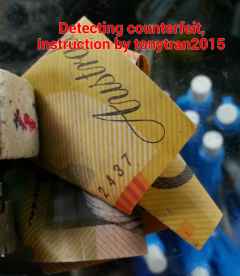


Figure 1: An Australian polymer note being scrunched, note the serial number. Figure 2: The same note recovers its original condition after 5 minutes. Figure 3: Comparison of the recovery of Australian polymer note after only 10 minutes and a Vietnamese note (printed on non-Australian polymer) after 24 hours. The Vietnamese note still had not recovered.
The polymer for Australian notes is soft, uncreasable but tough and is hard to tear at the edge. Counterfeit Australian dollars and counterfeit Vietnamese currency notes appearing in Vietnam are mostly made from non-tough materials [3].
Recovery and toughness tests are carried out by scrunching and by stretching the edge with your fingers . The note will spring back and will not be torn. ===>This test is good for Australian $50 notes, the note will be replaced free of charge with a new one at any Australian bank if it is not that tough.
Polymer currency not printed on that special Australian supplied polymer will not recover and is not that tough. For example, some genuine Vietnamese notes (using Australian technology but not printed on Australian supplied polymer) have been found to be unable to withstand the scrunching test and is not that tough (see the figures of this step and see also references [1], [2], [3]).
3. Integral clear plastic window with raised number and white stars by fused ink.
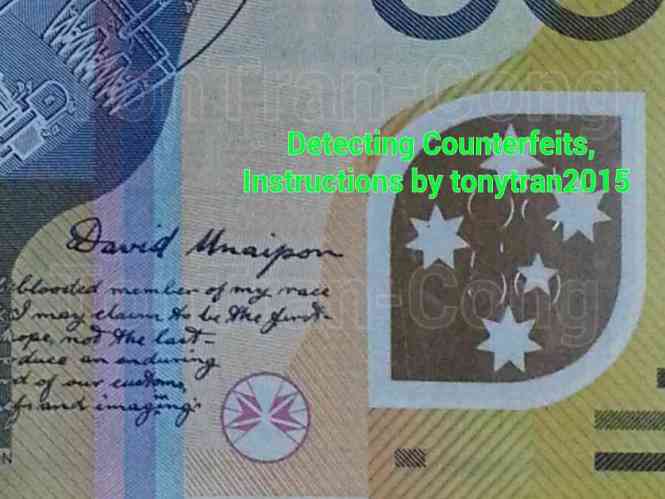
Figure 1: Integral clear plastic window with raised numbers and white stars printed with fused ink. The star wings inside a red circle at the bottom for alignment test and the weave patterns are also seen.
3/- There is an integral clear plastic window with raised numbers and white seven pointed stars printed with fused ink. The clear window cannot be detached from the note (The test is by scratching the edge of the clear windows with your fingernails). The white colour of the seven pointed stars have been fused into the polymer and can only be scratched off but cannot be rubbed off (The test for non-fused colours is by scratching the colours on the clear windows with your fingernails.) ===> These are effective features against counterfeits.
Polymer notes of other countries even have raised features on transparent windows. .
===> Counterfeiters are currently making only stuck on windows but they have produced clear windows with metal strips to make counterfeit $100 Canadian notes. (see [5].).
4. Fused inks for the whole note, some features are raised printed.

Figure 1: Surface texture of $50 AUS polymer note and print quality of its smallest letters.
All inks on the polymer notes are FUSED into the polymer base. Some features on Australian polymer notes are raised printed, they are printed with raised ink and have a feel of thickness [2]. The name of the country and other prints of the same colour are raised printed.
The created touch is commonly known as the touch feel of the note.
5. See through stars for checking double sided alignment.

Figure 1: An $100 AUD note with its magnified fine prints and its circled see through star on the bottom left corner.
A circled see through seven pointed star for checking the perfect alignment of double sided printing is placed on each polymer note. For a $50 AUD note, the star is near to the sharp bottom corners of the transparent window. (Alignment is checked by looking at images on both sides against any strong background light.). The gaps between the seven wings of the combined pictures from both side should be regular.
===> This is an effective feature against counterfeits.
6. Fine printing.
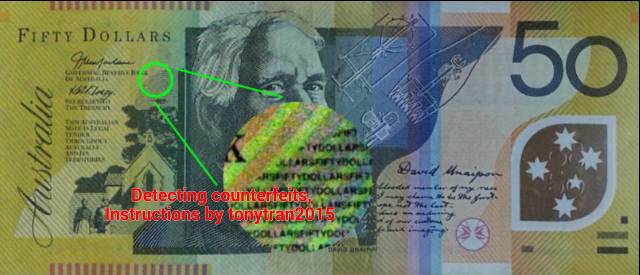

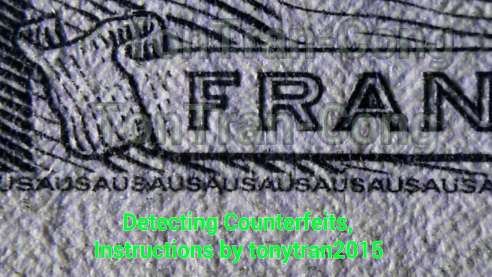
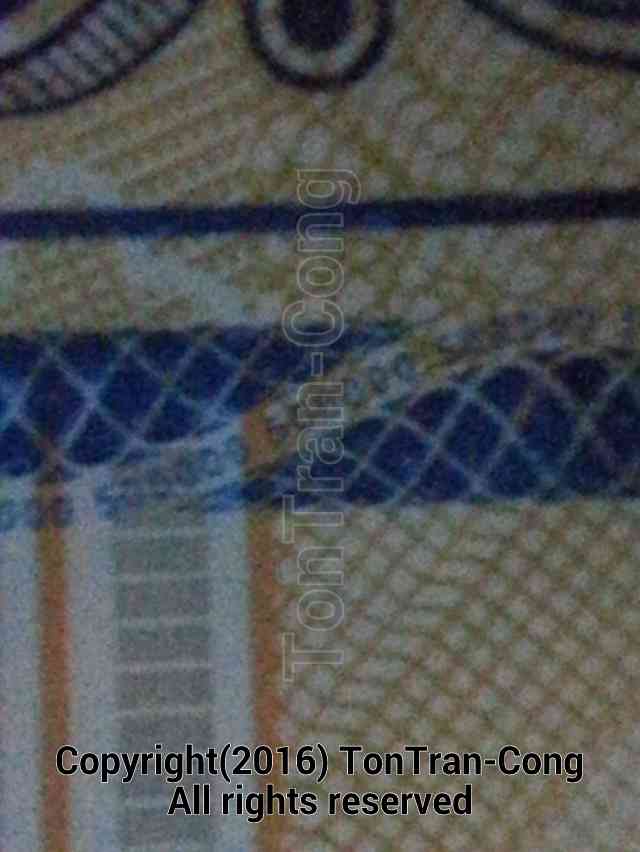
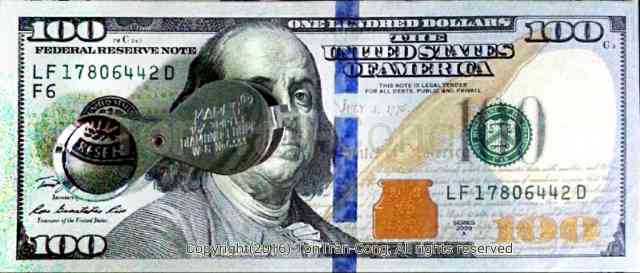
Figure 1: The front of a $50 AUS with indicated magnified fine printings and partially enhanced Australian coat of arms that is normally invisible. Figure 2, 3: Comparison fine printing of sizes 0.5mm and 0.2mm on US dollar note on cloth material, Figure 4: Comparison fine printing on a Vietnamese polymer note printed with licensed Australian technology. Figure 5: A quality 10X magnifying glass for seeing fine features on currency notes.
The fine printings on the Australian polymer notes compare well with the fine printing on the US cloth based notes and the Vietnamese polymer notes printed with licensed Australian technology.
The comparison figure shows US letters of height of 0.5mm (or 1/50inch) in bronze colour found on the curved character line bordering the unprinted area reserved for the hidden figure. It is near the green treasury seal.
===> You need to be familiar with these printings to check their quality.
Tools:
1. 10X magnifying glass. 2. You need to carry a $50 AUS note with you all the time to make non-arguable judgment on the print quality of notes.
7. Weave patterns of fine inclined lines.
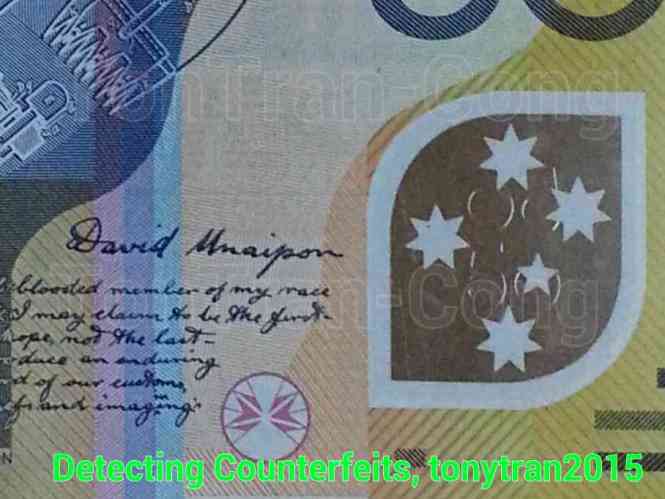

Figure 1: Clear window, alignment star and weave pattern on a $50 AUS note. Figure 2: Comparison figure of Vietnamese weave patterns. Vietnamese patterns are finer and more easily seen but are not as effective as Australian patterns.
Very fine weave patterns are printed on the front of the notes near the transparent window. The lines are inclined at various angles to stop counterfeiters from using inkjet printers to produce them. The lines will be badly broken up when printed by any ink-jet printer on counterfeits.
8. UV-light serial number features.
There are two serial numbers on the back side of each note. One of them lights up under UV light from common inexpensive torches. Under a short wavelength UV, a big number will appear showing the value of the note.
Note:
Counterfeiters have now used UV fluorescent ink [3].
9. Unused most effective available 1st line of defence: Holograms.


Figure 1: Looking at a LED torch through the anti-counterfeit hologram window of a Vietnamese polymer note reveals a hard to counterfeit pattern. Figure 2: Composite photos of the magnified views of a blue security band on a $100US note. The checker pattern on the blue security band moves smoothly downward when the viewing angle changes from left to right.
Note Printing Australia, a wholly owned subsidiary of the Reserve Bank of Australia has provided Vietnamese money Printer with a hologram technology for anti-counterfeiting. The technology has been applied to the Vietnamese currency worth more than $2US. This hologram method currently appears to be the MOST EFFECTIVE first defense line against counterfeit notes.
The new 100 US dollar notes have a blue hologram bands with tiny pictures of the number 100 in checker pattern. When the viewed at varying angle from left to right these patterns smoothly move downward as if they float on the notes.
Canadian 20 dollar notes have both see through and metallic holograms. Hologram technology should be added to Australian notes.
10. Unused most effective available 2nd line of defence: Burried hidden small print or a security wire


Figure 1: Small print is hidden inside the base material of a Vietnamese polymer note. Figure 2: Small print is hidden inside the base material of a US currency note made of cloth material.
Small print buried inside the base material now replaces the old metallic wire buried inside the base material. It is seen when the note is hold up against a strong background light. The technology has been applied to Vietnamese notes, it would be an effective addition to Australian notes.
===> Counterfeiters have produced hidden figures but they are too crude for security small prints.
11. Unused most effective available 3rd line of defence: Iridescent ink for features.
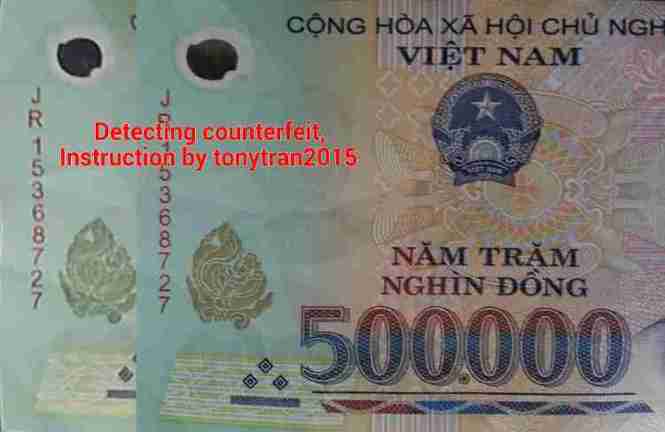
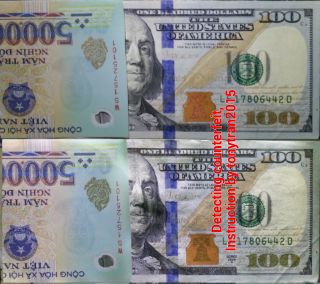
Figure 1: A Vietnamese note is placed flat on top of the left half of an US note, with its colour changing emblem near to the colour changing “bell in a bottle” of the $100US note. Both are shone by a strong light beam at normal angle (top picture) then at glancing angle (bottom picture). The change in colour (from bronze to green) on the $100US note is obvious while the change on Vietnamese note is barely noticeable. Figure 2: The gold coloured ink for the emblem of a coiled reptile (?) on a Vietnamese note is claimed to change to a grey metallic colour (left part of the composite photo) when viewed from a glancing angle under daylight. The technology has been shown applicable to polymer notes.
4/- On a cloth based $100 US note, the picture of a bell in a bottle can be made to clearly change from bronze to green by shining a strong light beam at normal and at glancing angle. The test is easy when you have a LED torch to shine a strong light beam onto the ink and change the beam angle from normal to glancing.
The technology has been applied to Vietnamese polymer notes with less effectiveness. The gold coloured ink for the emblem of a coiled reptile (?) on a Vietnamese note is claimed by Vietnamese State Bank to change to a grey metallic colour when viewed from a glancing angle under daylight. Although this anti-counterfeit feature does not seem to work well on Vietnamese polymer notes but could be made better if adopted on Australian notes.
12. Unused most effective available 4th line of defence: Magnetic ink.

Figure 1: The ink on any genuine US note is magnetic and is clearly seen attracted by a fridge magnet.
When holding the rectangular note vertically by grabbing its upper short side, you can easily see that the ink on the US dollar notes is attracted by a fridge magnet hold in the other hand.
Tool: You need a ceramic fridge magnet for this test.
It is desirable to have this technology added to polymer notes.
13. Effective detection strategy.
The seven tests have been given are in order of increasing difficulty. They are thus in the right order for an effective detection strategy. From my searches using the Internet, I have not found any case of counterfeit AUS dollars passing more than four of these eight tests.
NOTES:
1. There are also UV torches sold to detect counterfeit currencies of most countries but high quality UV lights are required for this anti-counterfeit feature on many new notes. A high quality UV light source has UV of short wavelength and narrow spectrum with little visible light emitted. It is neither small nor cheap.
2. Iodine pens give yellow ink mark which darkens to brown on contact with starch from ordinary paper. These pens are sold to detect fake US dollars and will not work on polymer notes.
Step 14: Reducing your exposure to counterfeit currency.
When traveling and using unfamiliar currency or when your senses are not acute, you can reduce your risk to counterfeit currency by adopting these cautionary rules:
1. Carry a variety of high value notes so that you can combine them to pay each of the purchase charges without receiving any change in high value notes.
2. Only receive high value currency notes from registered banks (They are obliged to check currency notes when receiving and give you genuine usable notes).
3. Ask the banks to give you the combinations suitable for your trip until your next bank visit.
NOTES:
Counterfeiters have had decades of practice in counterfeiting Vietnamese polymer currency [3,4] (printed under technology licensed by Note Printing Australia), They have been operating with little risk of apprehension across the borders there and they are so confident that they openly advertised their counterfeits to ignorant greedy people at 30% of the values of genuine money.
They have now targeted the Australian polymer dollars. This is not a surprise as Australia is the first country to issue polymer currency (since 1988) but its currency notes are now lacking modern effective anti-counterfeit features such as holograms and tiny hidden printing. Australia is now in the process of replacing her polymer notes. Five dollars notes are being replaced by the ones with more modern design and gradually larger denomination notes will also be replaced.

Figures: Front and back views of a new 5 Australian dollar note with transparent middle section
References.
[1]. Chris Vedelago, Cameron Houston, Australia flooded with fake $50 notes so good they fool banks, The Courier, http://www.thecourier.com.au/story/3757999/austral…, posted 28 Feb 2016.
[2]. Counterfeit Detection Guide, Could you spot a counterfeit banknote?, Reserve Bank of Australia, http://banknotes.rba.gov.au/counterfeit-detection…, accessed 20 July, 2016.
[3]. M.Anh, Cách nhận biết tiền giả 200.000 đồng, Báo VietNamNet,
http://vietnamnet.vn/vn/kinh-doanh/285822/cach-nha… posted 26/01/2016
[4]. Bắt khẩn cấp kẻ rao bán tiền giả trên Facebook, Báo VietNamNet, http://vietnamnet.vn/vn/kinh-doanh/287820/bat-kha…, posted 02/02/2016
[5]. Security Features, Bank of Canada, http://www.bankofcanada.ca/banknotes/bank-note-ser…, accessed 20 July 2016.
[6]. tonytran2015, Detecting Counterfeit Currency, US dollars, survivaltricks.wordpress.com, https://survivaltricks.wordpress.com/2016/07/15/detecting-counterfeit-currency-us-dollars/ … posted on Jul 15, 2016.
Click here for my related blogs on
Detecting counterfeit Australian polymer dollars with transparent stripes.

Detecting counterfeit currency US dollars
Click here for my other blogs on  MONEY
MONEY
SURVIVAL CONTENTS BLOG IMAGE OF SURVIVAL CONTENTS
![]()
MONEY CONTENTS BLOG IMAGE OF MONEY CONTENTS
SOCIAL ISSUES CONTENTS BLOG IMAGE OF CONT. OF SOCIAL ISSUES
LIVING BLOG LIVING CONTENTS BLOG IMAGE OF LIVING CONTENTS
HOW TO BLOG HOW TO CONTENTS BLOG IMAGE OF HOW TO CONTENTS
Click here go to  Home Page (Navigation-Survival-How To-Money).
Home Page (Navigation-Survival-How To-Money).
ARCHIVAL HOME PAGE CONTENTS HOME PAGE BLOG IMAGE OF CONTENTS HOME PAGE


We stumbled over here from a different page and thought I might check things out.
I like what I see so now i’m following you. Look forward to looking
into your web page yet again.
LikeLike
Excellent post. I was checking continuously this blog and I am impressed!
Very helpful info particularly the last part 🙂 I care for such info a lot.
I was seeking this particular info for a long time. Thank you and good
luck.
LikeLike
Thanks for finally talking about >Detecting counterfeit currency,
Australian dollars. – Additional survival tricks <Loved it!
LikeLike
Aliás, como é que podemos encontrar melhor preço?
LikeLike
I have learn some good stuff here. Certainly value bookmarking for revisiting. I wonder how so much attempt you set to create the sort of wonderful informative website.|
LikeLike
I think the admin of this website is genuinely working hard in support of his site, for the reason that here every stuff is quality based information.|
LikeLike
Thanks for finally talking about >Detecting counterfeit
currency, Australian dollars. – Additional survival tricks <Loved it!
LikeLike
I am extremely inspired with your writing skills as well as with the structure in your blog. Is that this a paid topic or did you customize it yourself? Anyway stay up the excellent quality writing, it’s uncommon to see a nice weblog like this one nowadays..|
LikeLike
Pretty! This was an extremely wonderful article. Thank you for supplying this info.|
LikeLike
Hello there, I found your site via Google at the same time as searching for a similar topic, your site came up, it appears great. I have bookmarked it in my google bookmarks.
LikeLike
What’s up, I read your blog regularly. Your humoristic style is witty, keep doing what you’re doing!|
LikeLike
Hi there to every body, it’s my first go to see of this website; this weblog contains remarkable and in fact good material for visitors.|
LikeLike
Oh my goodness! Amazing article dude! Thanks, However I am experiencing issues with your RSS. I don’t know why I cannot join it. Is there anybody getting the same RSS problems? Anyone that knows the answer can you kindly respond? Thanks!!|
LikeLike
Hey there I am so thrilled I found your webpage, I really found you by error, while I was looking on Yahoo for something else, Nonetheless I am here now and would just like to say thank you for a fantastic post and a all round thrilling blog (I also love the theme/design), I don’t have time to read it all at the minute but I have book-marked it and also added your RSS feeds, so when I have time I will be back to read a lot more, Please do keep up the fantastic job.|
LikeLike
I know this website presents quality dependent articles and additional material, is there any other web site which gives these kinds of stuff in quality?|
LikeLike
Usually I do not learn article on blogs, but I wish to say that this write-up very forced me to take a look at and do it! Your writing style has been amazed me. Thank you, very nice post.|
LikeLike
I will immediately clutch your rss feed as I can’t find your e-mail subscription link or newsletter service. Do you have any? Please let me realize in order that I may just subscribe. Thanks.|
LikeLike
My RSS feed is at the bottom of each blog page. There is no email subscription link.
LikeLike
Wow, fantastic blog layout! How long have you been blogging for? you make blogging look easy. The overall look of your site is great, as well as the content!|
LikeLike
Reblogged this on Ace Global News and commented:
Great post really informative and useful reading .. Have to say l an old fashioned do not like the new notes … But they are safer .. Well for now .. Ian 👍
LikeLiked by 1 person
Thank you, Ian, for re-blogging.
LikeLiked by 1 person
Welcome Tony … You put a lot of research and effort into your work and it needs sharing … Ian 😊
LikeLiked by 1 person